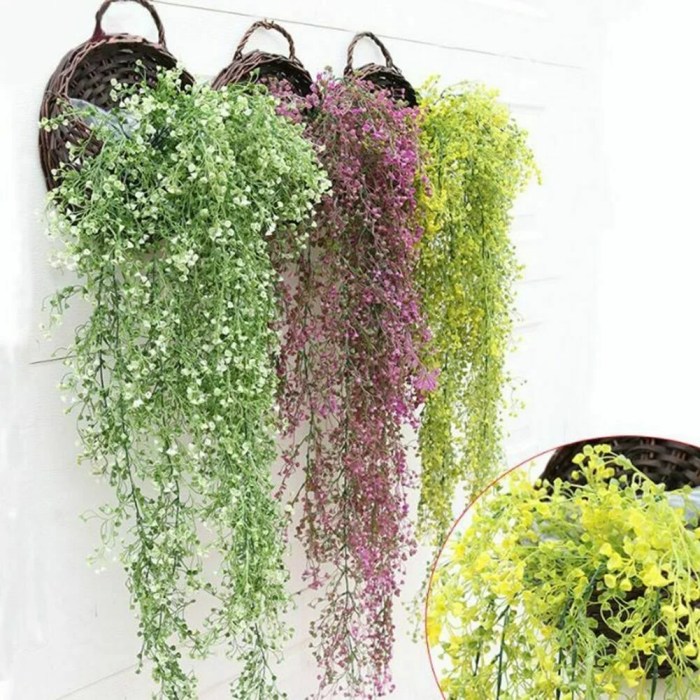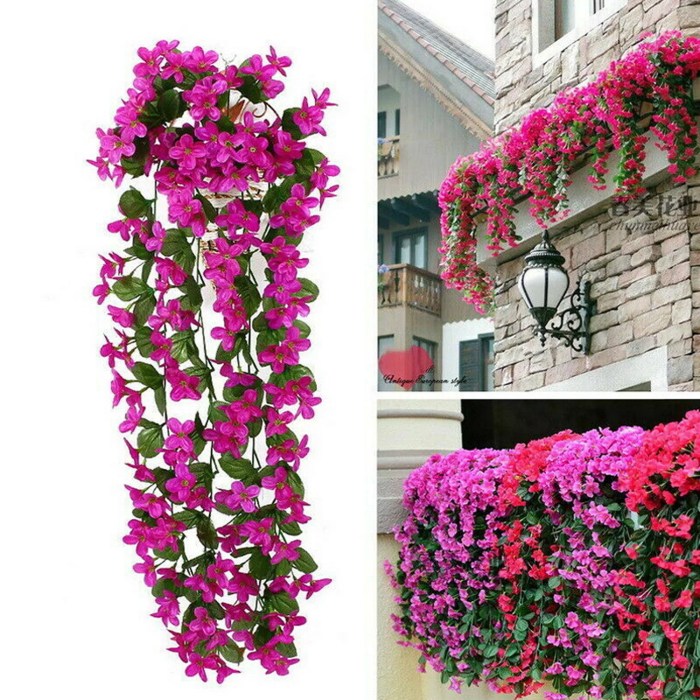Indoor hanging flowers bring a touch of nature and beauty to any home, offering a versatile and stylish way to add color, texture, and life to your living spaces. From cascading blooms to trailing vines, these plants offer a wide range of options to suit any taste and decor style.
Whether you’re a seasoned gardener or a novice looking to add some greenery to your home, this guide will provide you with all the information you need to select, care for, and enjoy indoor hanging flowers.
Types of Indoor Hanging Flowers
Indoor hanging flowers add a touch of elegance and beauty to any room. They are a great way to add a pop of color and life to your home. There are many different types of indoor hanging flowers to choose from, each with its own unique characteristics.
Some of the most popular indoor hanging flower varieties include:
- Spider Plant( Chlorophytum comosum): Spider plants are one of the most popular indoor hanging plants. They are easy to care for and produce long, trailing stems with small, white flowers.
- Pothos( Epipremnum aureum): Pothos is another popular indoor hanging plant. It is known for its variegated leaves and long, trailing stems. Pothos is a very low-maintenance plant and can tolerate a wide range of light conditions.
- Philodendron( Philodendron spp.): Philodendrons are a large genus of plants that includes many different species. They are known for their large, heart-shaped leaves. Philodendrons are relatively easy to care for, but they do require a bit more light than some other indoor hanging plants.
- String of Pearls( Senecio rowleyanus): String of Pearls is a unique indoor hanging plant that produces long, trailing stems with small, round leaves. The leaves resemble strings of pearls, giving the plant its name. String of Pearls is a relatively easy-to-care-for plant, but it does require bright light.
- Air Plant( Tillandsia spp.): Air plants are a unique type of plant that does not require soil to grow. They absorb nutrients from the air and water through their leaves. Air plants are a great choice for indoor hanging baskets because they are very low-maintenance.
Growing Conditions for Indoor Hanging Flowers
Providing optimal growing conditions is crucial for thriving indoor hanging flowers. These plants require specific light, temperature, humidity, and watering schedules to flourish.
Light Requirements
Most indoor hanging flowers prefer bright, indirect light. Direct sunlight can scorch leaves, while insufficient light can hinder growth. East- or west-facing windows provide ideal light conditions. If natural light is limited, consider using grow lights to supplement.
Temperature and Humidity
Hanging flowers thrive in moderate temperatures between 60-75°F (16-24°C). Avoid placing them near cold drafts or heat sources. High humidity is beneficial for most species, so misting the plants regularly or using a humidifier is recommended.
Watering Frequency
Water hanging flowers when the top inch of soil feels dry to the touch. Avoid overwatering, as soggy soil can lead to root rot. Use room-temperature water and allow excess water to drain away.
Creating a Suitable Growing Environment
Creating a suitable growing environment for indoor hanging flowers involves providing ample light, maintaining optimal temperature and humidity, and following a consistent watering schedule. By meeting these requirements, you can ensure healthy growth and vibrant blooms.
Care and Maintenance: Indoor Hanging Flowers

Maintaining indoor hanging flowers requires regular care to ensure their health and beauty. This includes fertilizing, pruning, repotting, watering, and managing pests and diseases.
Fertilizing
Fertilize indoor hanging flowers every two to four weeks during the growing season with a balanced liquid fertilizer. Follow the instructions on the fertilizer label for proper dilution.
Pruning
Regular pruning helps maintain the shape and size of indoor hanging flowers. Remove dead or damaged leaves and stems, and trim back overgrown stems to encourage new growth.
Repotting
Repot indoor hanging flowers every two to three years or when they become rootbound. Use a pot one size larger than the current pot and a well-draining potting mix.
Watering
Water indoor hanging flowers regularly, allowing the soil to dry out slightly between waterings. Avoid overwatering, as it can lead to root rot. Underwatering can cause the flowers to wilt and drop their leaves.
Hanging flowers indoors add a touch of greenery and freshness to any space. They can be used to create a vertical garden, or simply to add a splash of color to a room. One popular option for indoor hanging flowers is a wall hanging herb garden.
These gardens are a great way to grow fresh herbs indoors, and they can be easily customized to fit any space. For more information on how to create a wall hanging herb garden indoors, visit this website . Whether you choose to grow herbs or flowers, indoor hanging plants are a great way to add life and beauty to your home.
Pests and Diseases
Common pests that affect indoor hanging flowers include aphids, mealybugs, and spider mites. Treat infestations with insecticidal soap or neem oil. Common diseases include powdery mildew and botrytis. Treat diseases with fungicides or by improving air circulation.
Hanging flowers can instantly add life and beauty to any indoor space. Trailing plants are a popular choice for hanging baskets, as they can create a cascading effect that adds visual interest. If you’re looking for a low-maintenance option, consider trailing plants indoor artificial . These plants are made from high-quality materials that look and feel like real plants, but they require no watering or sunlight.
You can enjoy the beauty of hanging flowers without any of the hassle.
Decorative Uses of Indoor Hanging Flowers
Indoor hanging flowers add a touch of elegance and freshness to any home. They can be used in various ways to enhance the aesthetics of a room and complement different interior design styles.
Hanging in Windows
Hanging baskets filled with vibrant blooms can transform windows into eye-catching focal points. The sunlight streaming through the glass provides ample illumination for growth, and the flowers create a cheerful and inviting atmosphere.
Wall Decor
Vertical gardens and wall-mounted planters are excellent options for adding greenery and color to walls. Hanging flowers in these structures creates a stunning display that draws attention to the vertical space.
Indoor hanging flowers bring a touch of nature into any room, adding beauty and freshness. Whether you choose trailing vines or cascading blooms, these plants can instantly transform your space. For a dramatic effect, consider long hanging plants indoor that can reach impressive lengths.
These trailing varieties add a sense of movement and elegance, creating a lush and inviting atmosphere in any indoor setting.
Ceiling Installations, Indoor hanging flowers
Suspended from the ceiling, hanging flowers create a sense of drama and grandeur. They can be used to delineate spaces, highlight architectural features, or simply add a touch of whimsy to a room.
Complementing Interior Design Styles
The aesthetic appeal of indoor hanging flowers varies greatly depending on the variety chosen. From delicate trailing vines to bold, cascading blooms, there is a flower to suit every style.
- Modern:Sleek, geometric shapes and neutral colors, such as white orchids or hanging succulents.
- Bohemian:Eclectic and colorful, featuring macrame hangers and trailing plants like pothos or spider plants.
- Traditional:Classic and elegant, with lush blooms such as hanging geraniums or petunias.
Creative Arrangements
In addition to traditional hanging baskets, there are many creative ways to incorporate indoor hanging flowers into home decor.
- Terrariums:Glass containers filled with miniature plants, including hanging ferns or air plants.
- Macrame Swings:Woven macrame hangers create a unique and bohemian way to display hanging plants.
- Hanging Planters:Handmade or purchased hanging planters made of various materials, such as metal, wood, or ceramic, add a personal touch.
Unique Designs and Arrangements

Indoor hanging flowers can be arranged in a myriad of creative ways to enhance the aesthetic appeal of any space. From macrame hangers to geometric planters, these innovative designs offer endless possibilities for showcasing your floral creations.
Macrame Hangers
Macrame hangers, with their intricate knots and delicate designs, add a bohemian touch to hanging flower arrangements. They can be crafted in various sizes and shapes, allowing you to customize the display to suit your style and space. When selecting plants for macrame hangers, choose trailing varieties such as pothos, ivy, or string of pearls that will gracefully cascade down the cords.
Geometric Planters
Geometric planters, with their clean lines and angular shapes, provide a modern and elegant backdrop for hanging flowers. They come in a variety of materials, including metal, ceramic, and wood, and can be arranged in clusters or suspended individually. Succulents and air plants are ideal for geometric planters, as their compact size and minimal water requirements make them well-suited for these enclosed spaces.
Cascading Displays
Cascading displays create a dramatic and eye-catching effect by suspending multiple hanging baskets or planters at different heights. This arrangement allows for a mix of plants with varying textures, colors, and growth habits. Trailing plants like spider plants, ferns, and philodendrons are perfect for cascading displays, as they will gracefully flow over the edges of the containers.
Ultimate Conclusion

With proper care and attention, indoor hanging flowers can thrive for years, adding a touch of beauty and freshness to your home. So why not embrace the charm of these versatile plants and bring the outdoors in?
FAQ Explained
What are the most popular types of indoor hanging flowers?
Some of the most popular indoor hanging flowers include spider plants, pothos, philodendrons, ferns, and hoyas.
How much light do indoor hanging flowers need?
Most indoor hanging flowers prefer bright, indirect light. However, some varieties, such as ferns, can tolerate lower light levels.
How often should I water indoor hanging flowers?
The frequency of watering will vary depending on the type of plant, the size of the pot, and the humidity levels in your home. A good rule of thumb is to water when the top inch of soil feels dry to the touch.